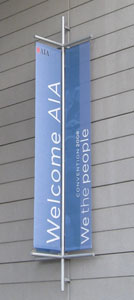by: Jessica Sheridan Assoc. AIA LEED AP
Event: 2008 AIA National Convention
Location: Boston Convention and Exhibition Center, Boston, 05.15-17.08
Speakers: Go to the AIA Convention website for information on all speakers and events
“We the People,” this year’s theme at the AIA National Convention, urged architects to improve communities, locally and worldwide. Keynotes featured Ambassador Andrew Young, who stressed the need for the profession to diversify; Habitat for Humanity founder Millard Fuller, who encouraged architects to put up affordable housing; and a panel moderated by International Center for Urban Security founder Thomas Vonier, FAIA, who asked architects to focus on civic architecture despite a time of increased security and political turmoil. Sustainability, affordable housing, urban security, and diversity permeated many discussions at the Rafael Viñoly Architects-designed Boston Convention and Exhibition Center.
Focus on Civic Architecture
“It is deplorable that few architects get involved or are friends with politicians in the public realm,” stated Ambassador Richard Swett, FAIA, vice president and managing principal at Washington D.C.-based Leo A Daly during the Civic Architecture: Design and Identity in a Changing Society panel. Although this was a common sentiment at the convention, firms nationwide are addressing the issue by getting more involved in civic architecture. Until recently, government buildings were seen as limited to Classical design and political ruthlessness, Swett said. But Edward Feiner, FAIA, senior vice president and chief architect at Las Vegas Sands Corporation and former chief architect at the U.S. General Services Administration (GSA), believes that architects can be a catalyst for change in the public realm; public buildings can complete a “civic vision.”
After the Oklahoma City bombing and 9/11, the GSA began to readdress the security needs of public sector facilities by holding charrettes in most major cities. Structural hardening, blast-resistant glazing, a 50-foot standoff perimeter, increased lighting, and site surveillance are some of the measures introduced in the GSA Perimeter Security Guide (the AIA and American Society of Landscape Architects (ASLA) participated in putting together this document as well). As federal buildings bulked up to protect civilians, the GSA also began encouraging sustainable design. By designing buildings that incorporate natural light, hidden security, and the setback rule to create urban plazas, the hope is that civilians will want to visit new civic buildings and spend time in their open spaces, according to GSA chief architect, Les Shepherd, AIA.
In addition to developing new building codes, there are other steps possible to foster change. Swett stated that education is key — civic design should be integrated into architecture school curricula (possibly as studio projects), architects should educate their clients, and the GSA must educate government officials. For Shepherd, civic buildings must remain in city centers to encourage communities to trust that their governments are concerned with their safety.










